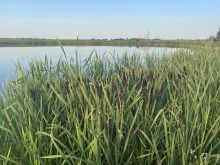There may be sales opportunities hiding in the prairie drought,
depending on what farmers seed.
Concerned that grain crops might not yield well in the dry conditions,
some producers are considering harvesting their cereals as greenfeed.
Agronomists say they shouldn’t have to look too far for a ready market.
Even if timely rains arrive this year, it will be too late to improve
many pastures and perennial forages in Western Canada. Grass-dependent
livestock producers will need to find other feed sources.
Read Also

Europe holds promise for Canadian lentils
Pulse Canada is trying to help boost lentil consumption in Europe, which is already the fourth largest market.
Glen Shaw of the federal Prairie Farm Rehabilitation Administration
said forage yields will be disappointing this year.
“Even if it does start to rain now, it is too late for most tame hay.
Yields are going to be below average this season. … Most established
cattle producers keep two years of feed on hand, but that is gone. If
they haven’t already, they will have to turn to the market for feed
this year,” he said.
The price for good hay has risen to the point where quality greenfeed
may bring better returns than grain produced on the same land.
Don Green of Manitoba Agriculture said producers should consider their
individual situations carefully, but the economics of greenfeed may be
right.
“It can really pay off if the producer also has livestock to feed,”
said the forage specialist. “If you are buying feed at high prices and
paying to truck it as well, it might make sense to harvest that cereal
crop at home with a baler instead of a combine.
“If hay is costing you $150 per tonne and you are able to grow 1.5
tonnes per acre in tough conditions … you do the math. This makes
grain look less inviting,” he said.
At Saskatoon last year, hard hit by drought, Saskatchewan Forage
Council trials for cereal greenfeeds indicated barley was the best
choice for 2001.
On average, the barleys yielded about 0.6 tonnes to the acre while oats
provided only 0.4 tonnes. Triticale and wheat were less at 0.36 tonnes.
Grain yields in the same areas reported barley at 14 bushels to the
acre, oats and wheat at 10, according to Saskatchewan’s agriculture
department.
Shaw added that greenfeed might be a viable alternative for producers
who are considering summerfallow because of uneconomic grain production.
That’s especially true if they are considering tillage summerfallow.
“We really want to avoid the soil erosion that can occur,” Shaw said.
Costs of rental equipment or custom baling can reduce potential profits
on the greenfeed. Farmers should also consider whether they have the
infrastructure to process large quantities of good quality hay when
deciding if they should grow grain or greenfeed.
Grazing an annual cereal crop can also be effective.
“A mix of winter wheat or fall rye with oats or barley or annual rye
grass can usually support half to three-quarters of a cow-calf pair per
acre for a four month grazing season,” said Green.
Shaw said managing the grazing of the annual crop is key.
Animals should be rotated after seven days and should not be allowed to
graze regrowth until it has had a chance to establish.
Seeding rates for spring-seeded cereals for greenfeed
(lb./acre) dry soil moist soil
Oats 75 95
Barley 75 75
Triticale 110 125
Fall rye 80 100
Winter wheat 90 110














